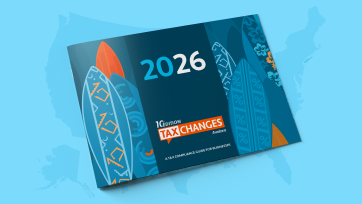Tax advantages of chocolate-free gingerbread – Wacky Tax Wednesday
The Nightmare before Christmas, tax version.
Last weekend, my daughter retreated to the kitchen, cranked Christmas tunes, and settled in for an afternoon of baking gingerbread. I was all for it. I’m crazy for gingerbread but tend to space out while baking, so my cookies are usually a catastrophe. Fortunately, my girl inherited her dad’s cookie-baking skills. If only she shared my post-cooking-kitchen-cleaning compulsion.
She who bakes has creative control, and so this year’s gingerbread ladies and gents are clothed in bold blues, greens, and blacks. They sport shirts, hair bows, and ties, but not chocolate. Although when she was younger, my girl loved to pile on the chocolate chips or make giant, Hershey-kiss buttons, she’s now too much the artist for that. Or perhaps she’s simply attuned to the quirkiness of tax law. Because — in the United Kingdom, at least — how gingerbread is dressed affects how it’s taxed.
Choose your gingerbread decorations wisely
A notice on the taxability of food, issued by Her Majesty’s Revenue & Customs to illuminate Britain’s Value Added Tax Act of 1994, divides food into two categories: “Zero-Rated,” which is exempt from value added tax (VAT), and “Standard-Rated,” subject to the normal VAT. Gingerbread makes the list twice:
- “Slab gingerbread” (my favorite kind) falls under “Zero-Rated”
- “Gingerbread men decorated with chocolate unless this amounts to no more than a couple of dots for eyes” is listed under “Standard-Rated”
I’m certain a good tax attorney could have a field day with this. Under this definition, for example, gingerbread men with “a couple of dots” of chocolate for buttons — not eyes — could be exempt. And since the law specifies the gender, it leaves gingerbread ladies free to dress as they please, with no adverse tax consequence. Or at least it could.
Confounding tax policy doesn’t stop with gingerbread. The list of Zero-Rated Confectionery includes: “Biscuits
[known in the U.S. as cookies] coated with icing, caramel or some other product different in taste and appearance from chocolate.” Why would caramel-coated biscuits be exempt but chocolate-coated biscuits (including my favorite, the McVities Digestive with dark chocolate) be taxable?
At first, I suspected an anti-chocolate conspiracy at Britain’s ministry of taxation (HRMC), or a powerful lobby that profits from the downfall of cacao products. But no, it turns out that not all chocolate-infused products are taxable. “Crunch cakes” (“breakfast cereal products coated in chocolate or carob and pressed into brittle flat cakes”) are exempt. Scottish snowballs, defined as “a dome of marshmallow coated with chocolate or coconut,” also make the zero-rated list. Furthermore, the list of exempt confectionery items includes chocolate body paint. Chocolate body paint! Those Brits must be racier than I thought.
I looked up the law to see if it could illuminate British food product taxability. Alas, I found myself confronted with this explanation of zero-rated food:
“The supply of anything comprised in the general items set out below, except … a supply of anything comprised in any of the excepted items set out below, unless it is also comprised in any of the items overriding the exceptions set out below which relates to that excepted item."
I’m so confused by that statement that I can’t begin to figure out how it impacts this one, listed further on in the law under “Excepted items;”
Confectionary, not including cakes or biscuits other than biscuits wholly or partly covered with chocolate or some product similar in taste and appearance.”
So back to the notice, my life raft. It explains that the standard-rate VAT is required for “confectionery, apart from cakes and some biscuits.” Biscuits most at risk for being taxed include chocolate — but not chocolate in any old form.
For example, if the chips in chocolate chip biscuits “are either included in the dough or pressed into the surface before baking,” the cookie is exempt. But if they’re “wholly or partly coated” in chocolate, the cookie is taxed at the standard rate. “Bourbon and other biscuits where the chocolate or similar product forms a sandwich layer between two biscuit halves and is not continued onto the outer service” are taxed at a rate of zero; “chocolate covered shortbread” gets the standard rate. And so on.
I’m sure that these product taxability rules were created with the best of intentions, although I can’t imagine what those intentions were. But while they’re good for a laugh, they make tax compliance extremely challenging for retailers tasked with assigning tax to all the biscuits on their shelves.
Outsourcing VAT facilitates global tax compliance. Learn more.

Avalara Tax Changes 2026 is here
The 10th edition of our annual report engagingly breaks down key policies related to sales tax, tariffs, and VAT.
Stay up to date
Sign up for our free newsletter and stay up to date with the latest tax news.














